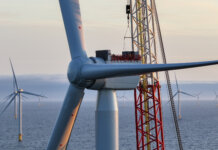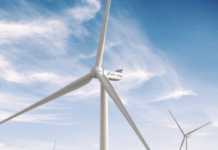GE Renewable Energy has acquired a minority investment in COBOD International, the company providing the 3D printer used at GE’s Bergen, N.Y., research facility.
The two companies recently inaugurated the new research and development facility that will conduct research on how to 3D print the concrete base of towers used in wind turbines. The research will enable GE Renewable Energy to develop new production methods to make wind turbine towers more efficient and sustainable.
The 3D concrete printer is one of the first 3D concrete printer in the world to have two X-axes – one for doing the printing of concrete and the other for doing the reinforcement.
“This agreement, which will further strengthen our ability to use COBOD’s 3D printing technology and competences in the renewable energy space, is another sign of our commitment to help drive the energy transition by investing in technology that promotes a more sustainable, circular design strategy and helps to create local jobs,” says Matteo Bellucci, GE Renewable Energy’s advanced manufacturing technology leader. “Since we started cooperating with COBOD, the company has continued to improve their technical competence and innovative solutions, reinforcing the benefits of solidifying the relationship between our companies.”
“I am extremely proud that such an iconic and world class company like GE would like to partner with COBOD and help us deliver on the automated construction solutions of the future,” states Henrik Lund-Nielsen, COBOD’s founder and general manager. “Since 2019, when we began cooperating with GE, we have already sharpened our R&D competence, engineering and industrial skills significantly as a direct result of the cooperation, and we look very much forward to continuing benefitting from the vast resources of GE.”
Wind turbine towers are not the only non-residential low-rise applications for COBOD’s technology. COBOD’s printers are also known for having printed both offices in Denmark and Austria, schools in Africa, two- and three-story houses and apartment buildings in Germany as well as concrete structures for the oil and gas industry, made in cooperation with engineering, procurement and contracting companies.




